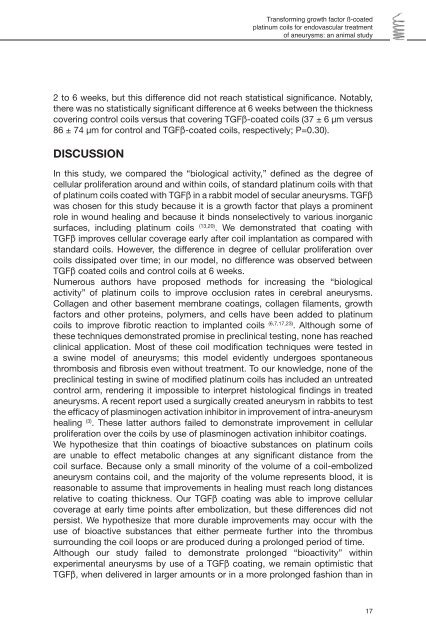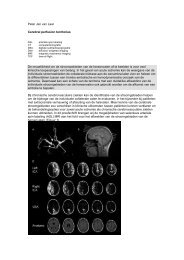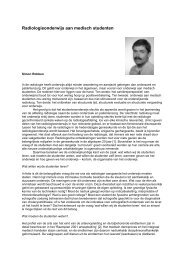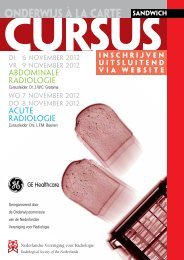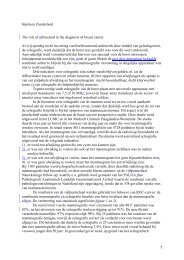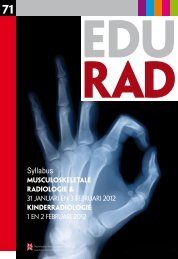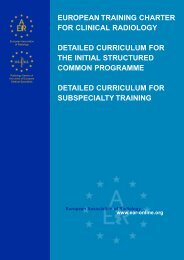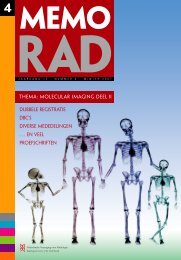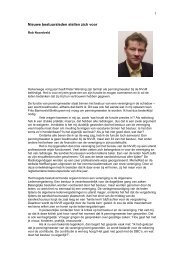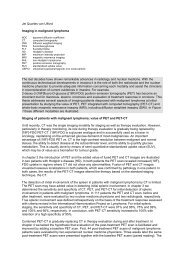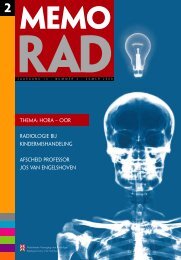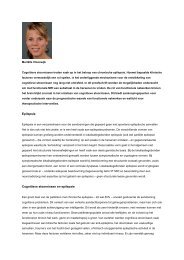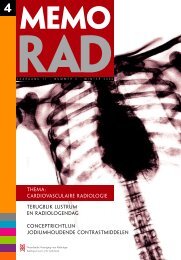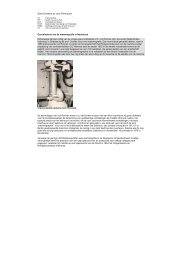Proefschrift - anjob Nathalie de Gast
Proefschrift - anjob Nathalie de Gast
Proefschrift - anjob Nathalie de Gast
Create successful ePaper yourself
Turn your PDF publications into a flip-book with our unique Google optimized e-Paper software.
Transforming growth factor ß-coated<br />
platinum coils for endovascular treatment<br />
of aneurysms: an animal study<br />
2 to 6 weeks, but this difference did not reach statistical significance. Notably,<br />
there was no statistically significant difference at 6 weeks between the thickness<br />
covering control coils versus that covering TGFß-coated coils (37 ± 6 μm versus<br />
86 ± 74 μm for control and TGFß-coated coils, respectively; P=0.30).<br />
DISCUSSION<br />
In this study, we compared the “biological activity,” <strong>de</strong>fined as the <strong>de</strong>gree of<br />
cellular proliferation around and within coils, of standard platinum coils with that<br />
of platinum coils coated with TGFß in a rabbit mo<strong>de</strong>l of secular aneurysms. TGFß<br />
was chosen for this study because it is a growth factor that plays a prominent<br />
role in wound healing and because it binds nonselectively to various inorganic<br />
surfaces, including platinum coils (13,20) . We <strong>de</strong>monstrated that coating with<br />
TGFß improves cellular coverage early after coil implantation as compared with<br />
standard coils. However, the difference in <strong>de</strong>gree of cellular proliferation over<br />
coils dissipated over time; in our mo<strong>de</strong>l, no difference was observed between<br />
TGFß coated coils and control coils at 6 weeks.<br />
Numerous authors have proposed methods for increasing the “biological<br />
activity” of platinum coils to improve occlusion rates in cerebral aneurysms.<br />
Collagen and other basement membrane coatings, collagen filaments, growth<br />
factors and other proteins, polymers, and cells have been ad<strong>de</strong>d to platinum<br />
coils to improve fibrotic reaction to implanted coils (6,7,17,23) . Although some of<br />
these techniques <strong>de</strong>monstrated promise in preclinical testing, none has reached<br />
clinical application. Most of these coil modification techniques were tested in<br />
a swine mo<strong>de</strong>l of aneurysms; this mo<strong>de</strong>l evi<strong>de</strong>ntly un<strong>de</strong>rgoes spontaneous<br />
thrombosis and fibrosis even without treatment. To our knowledge, none of the<br />
preclinical testing in swine of modified platinum coils has inclu<strong>de</strong>d an untreated<br />
control arm, ren<strong>de</strong>ring it impossible to interpret histological findings in treated<br />
aneurysms. A recent report used a surgically created aneurysm in rabbits to test<br />
the efficacy of plasminogen activation inhibitor in improvement of intra-aneurysm<br />
healing (3) . These latter authors failed to <strong>de</strong>monstrate improvement in cellular<br />
proliferation over the coils by use of plasminogen activation inhibitor coatings.<br />
We hypothesize that thin coatings of bioactive substances on platinum coils<br />
are unable to effect metabolic changes at any significant distance from the<br />
coil surface. Because only a small minority of the volume of a coil-embolized<br />
aneurysm contains coil, and the majority of the volume represents blood, it is<br />
reasonable to assume that improvements in healing must reach long distances<br />
relative to coating thickness. Our TGFß coating was able to improve cellular<br />
coverage at early time points after embolization, but these differences did not<br />
persist. We hypothesize that more durable improvements may occur with the<br />
use of bioactive substances that either permeate further into the thrombus<br />
surrounding the coil loops or are produced during a prolonged period of time.<br />
Although our study failed to <strong>de</strong>monstrate prolonged “bioactivity” within<br />
experimental aneurysms by use of a TGFß coating, we remain optimistic that<br />
TGFß, when <strong>de</strong>livered in larger amounts or in a more prolonged fashion than in<br />
17


